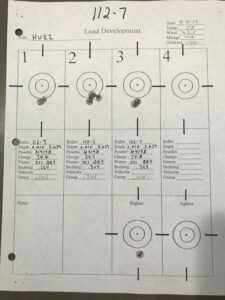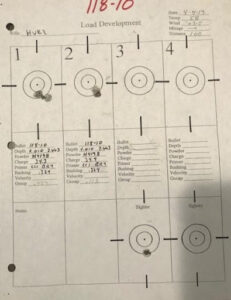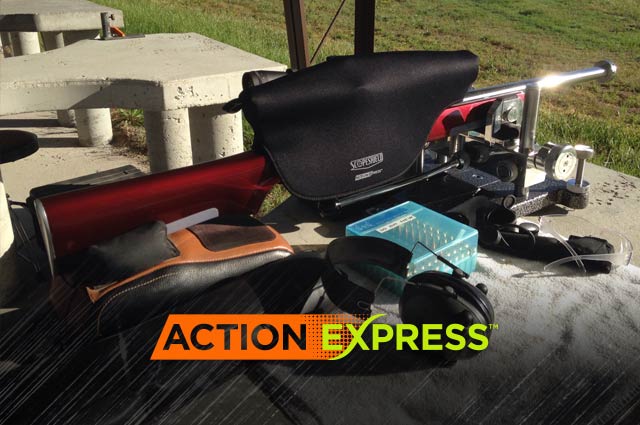In the previous post of this series on tuning a rifle barrel, National Benchrest Champion, Jason Stanley, started developing a trend for powder charge. In this post, he establishes the powder tune window and solidifies the best bullet for his rifle. His technique and approach are helpful lessons for anyone sighting in a rifle.
Landing on the Best Bullet for the Rifle
Range Day 4: 4-4-19 = 58 degrees F. 3-5 mph wind, slight mirage.
This afternoon had the conditions I had been waiting for; cloudy, 58 degrees, with a decently stable wind (it did flip on me a couple times). I was surprised at the amount of mirage for this cloudy of a day – however, the mirage was very readable.
I shot five different three shot groups. With the 112-7 bullet I loaded three rounds each with 34.6, 34.7, 34.8 gr of H4198. With the 118-10 I loaded three rounds each with 34.3 and 34.4 gr of H4198. All five groups had the same .324 bushing, +.010 jam, and CCI BR4 primers.

112-7 Group Target 2: Variable = Powder Charge

118-10 Group Target 2: Variable = Powder Charge
As you can see from the targets, the 112 again shot better as a whole than the 118. This
is the fourth piece of data that shows me the barrel prefers the 112 over the 118 at this time. Also, out of the five groups with the 112’s, three of them have measured a low one and another group a low two. Due to the 118-10 shooting some pretty decent groups with 34.4 and 34.5 gr, I might revisit the 118-10 as the barrel settles in and ages. To start the season, I will shoot the 112-7.
Defining the Powder Charge Tune Window
These 112-7 group targets are also pointing towards 34.7 gr of H4198. 34.6 gr of H4198 shot a .102” and 34.8 shot a .114”. The 34.7 shot an ugly .341” but I completely missed a wind change and a mirage flip. 100% my fault and I knew it when I pulled the trigger both times. Remember, one group does not make the tune and therefore one group cannot ruin the tune. However, I really wish that 34.7 would have been another low one group. That would have erased any doubt about 34.7 gr of H4198.
Finding the Edges of the Tune Window
I also like the 34.7 gr. charge because I know the 34.6 and the 34.8 can both shoot well. This gives me a cushion, or tune window, in which I have some margin of error when loading and also so the load will be able to handle changes in temperature, humidity, and altitude. When sighting in a rifle, I want to find the edges of the tune window then go right in the middle. This is what I meant, when I mentioned earlier, that I want a forgiving load.
I am not going to shoot 34.9 for two reasons; one is I am already slightly compressing the powder with the bullet. If I keep going up in powder charge the powder could start pushing the bullet out changing my seating depth. The second reason is as the temperature rises, so does the pressure. I need a load that will shoot in temperatures from 50-95. Maxing a load out when it is only 60 degrees is a recipe for disaster when the temperature climbs later in the summer.
Sighting in a Rifle With the Best Bullet and Powder Window
The BIB 112-7 shot better overall with many different powder charges than the BIB 118-10. When shooting groups with the 112s the charge of 34.5 shot a .206” group. 34.6 shot .102”. 34.7 shot .100” and 34.8 shot .114”. The last three powder charges all shot in the low ones. That is the tune window I am referring to. Right now, it looks like the BIB 112-7, 34.7 gr of H4198, with CCI BR 4 primers is in the middle of that tune window. I will try and fine-tune this load by trying different seating depths and neck tensions.
Up Next: Finding the Best Seating Depth and Neck Tension
In the next post of this series, Jason starts determining the seating depth tune window and finds the best neck tension for his rifle. If you’re new to sighting in a rifle, we encourage you to check our first post on tuning a rifle barrel.





